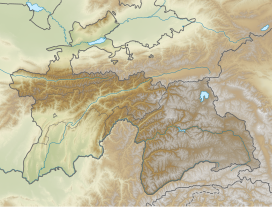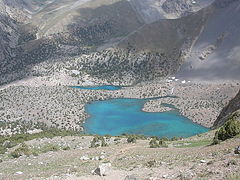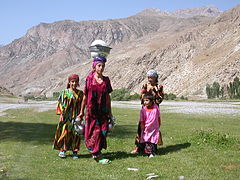Fann Mountains: Difference between revisions
Rescuing 1 sources and tagging 0 as dead.) #IABot (v2.0 |
LuckyTime154 (talk | contribs) took out some inaccuracies, minor wording updates |
||
| Line 43: | Line 43: | ||
}} |
}} |
||
'''Fann Mountains''' ({{lang-tg|Кӯҳҳои Фон}}, {{lang-uz|Fon togʻlari}}; also known as |
'''Fann Mountains''' ({{lang-tg|Кӯҳҳои Фон}}, {{lang-uz|Fon togʻlari}}; also known as the Fanns) are part of the western [[Pamir-Alay]] mountain system and are primarily located in [[Tajikistan]]'s [[Sughd Province]] between the [[Zarafshan Range]] to the north and the [[Gissar Range]] to the south.<ref>{{cite web|last1=Latombe|first1=Jean-Claude|title=Zigzagging in the Fann Mountains|url=https://ai.stanford.edu/~latombe/mountain/photo/central-asia-06/fann-06.htm|authorlink=Jean-Claude Latombe|publisher=Stanford University}}</ref> In the east-west direction they extend from [[Fan Darya|Fandarya River]] to Archimaydan River, and the cluster of Marguzor lakes known as the 7 lakes west of Archimaydan is also included in the Fanns. |
||
==Peaks== |
==Peaks, lakes and access== |
||
The Fanns boast about a hundred peaks, with several rising to altitudes of more than 5,000 meters and relative elevations of up to 1,500 meters.<ref>{{cite web|title=Fann mountains|url=http://www.traveltajikistan.net/gosee/fann_mountains/|website=TravelTajikistan.net|accessdate=15 September 2015}}</ref> The highest point in Fann Mountains is Chimtarga peak (5,489 m). Other 5,000-meter peaks are Bodkhona (5,138 m), Chapdara (5,050 m), Big Hansa, Little Hansa (5,031 m), Zamok ('5,070 m), Mirali (5,132 m), and Energia (5,120 m). |
The Fanns boast about a hundred peaks, with several rising to altitudes of more than 5,000 meters and relative elevations of up to 1,500 meters.<ref>{{cite web|title=Fann mountains|url=http://www.traveltajikistan.net/gosee/fann_mountains/|website=TravelTajikistan.net|accessdate=15 September 2015}}</ref> The highest point in Fann Mountains is Chimtarga peak (5,489 m). Other 5,000-meter peaks are Bodkhona (5,138 m), Chapdara (5,050 m), Big Hansa, Little Hansa (5,031 m), Zamok ('5,070 m), Mirali (5,132 m), and Energia (5,120 m). |
||
| ⚫ | |||
;Lakes |
|||
| ⚫ | |||
| ⚫ | The best time for visiting is late June–mid-September for trekking and July–August for mountaineering, when the weather is usually at its best. Access is generally from [[Panjakent]], which can be reached either from [[Dushanbe]] or [[Samarkand]].<ref>{{Cite web|url=https://caravanistan.com/tajikistan/north/fann-mountains/|title=Fann mountains trekking: a guide|website=Caravanistan|language=en-US|access-date=2020-02-26}}</ref> |
||
;Access |
|||
| ⚫ | |||
{| |
{| |
||
|<gallery mode=packed> |
|<gallery mode=packed> |
||
| Line 73: | Line 71: | ||
==External links== |
==External links== |
||
{{commons category|Fann Mountains}} |
{{commons category|Fann Mountains}} |
||
* |
*[http://www.ewpnet.com/fannmap.htm 1:100,000 topographical tourist map of the Fann Mountains] |
||
* [https://web.archive.org/web/20090502223653/http://mountains.tos.ru/fansk_m.htm Mountaineering map of the Fanns] |
|||
* [http://www.ewpnet.com/fannmap.htm 1:100,000 topographical tourist map of the Fann Mountains] |
|||
[[Category:Mountain ranges of Tajikistan]] |
[[Category:Mountain ranges of Tajikistan]] |
||
Revision as of 07:33, 26 February 2020
| Fann Mountains | |
|---|---|
 | |
| Highest point | |
| Elevation | 5,489 m (18,009 ft) |
| Parent peak | Chimtarga Peak |
| Coordinates | 39°10′00.0″N 68°15′00.0″E / 39.166667°N 68.250000°E |
| Naming | |
| Native name | Кӯҳҳои Фон / Fon togʻlari Error {{native name checker}}: parameter value is malformed (help) |
| Geography | |
| Location | Tajikistan and Uzbekistan |
| Parent range | Pamir-Alay |
Fann Mountains (Template:Lang-tg, Template:Lang-uz; also known as the Fanns) are part of the western Pamir-Alay mountain system and are primarily located in Tajikistan's Sughd Province between the Zarafshan Range to the north and the Gissar Range to the south.[1] In the east-west direction they extend from Fandarya River to Archimaydan River, and the cluster of Marguzor lakes known as the 7 lakes west of Archimaydan is also included in the Fanns.
Peaks, lakes and access
The Fanns boast about a hundred peaks, with several rising to altitudes of more than 5,000 meters and relative elevations of up to 1,500 meters.[2] The highest point in Fann Mountains is Chimtarga peak (5,489 m). Other 5,000-meter peaks are Bodkhona (5,138 m), Chapdara (5,050 m), Big Hansa, Little Hansa (5,031 m), Zamok ('5,070 m), Mirali (5,132 m), and Energia (5,120 m).
There are many lakes in the Fanns.The best known are Alaudin lakes in the Chapdara River valley, Kulikalon Lakes on the northern slope of Chimtarga peak, Big Allo Lake and Iskanderkul Lake.
The best time for visiting is late June–mid-September for trekking and July–August for mountaineering, when the weather is usually at its best. Access is generally from Panjakent, which can be reached either from Dushanbe or Samarkand.[3]
|
See also
References
- ^ Latombe, Jean-Claude. "Zigzagging in the Fann Mountains". Stanford University.
- ^ "Fann mountains". TravelTajikistan.net. Retrieved 15 September 2015.
- ^ "Fann mountains trekking: a guide". Caravanistan. Retrieved 2020-02-26.









